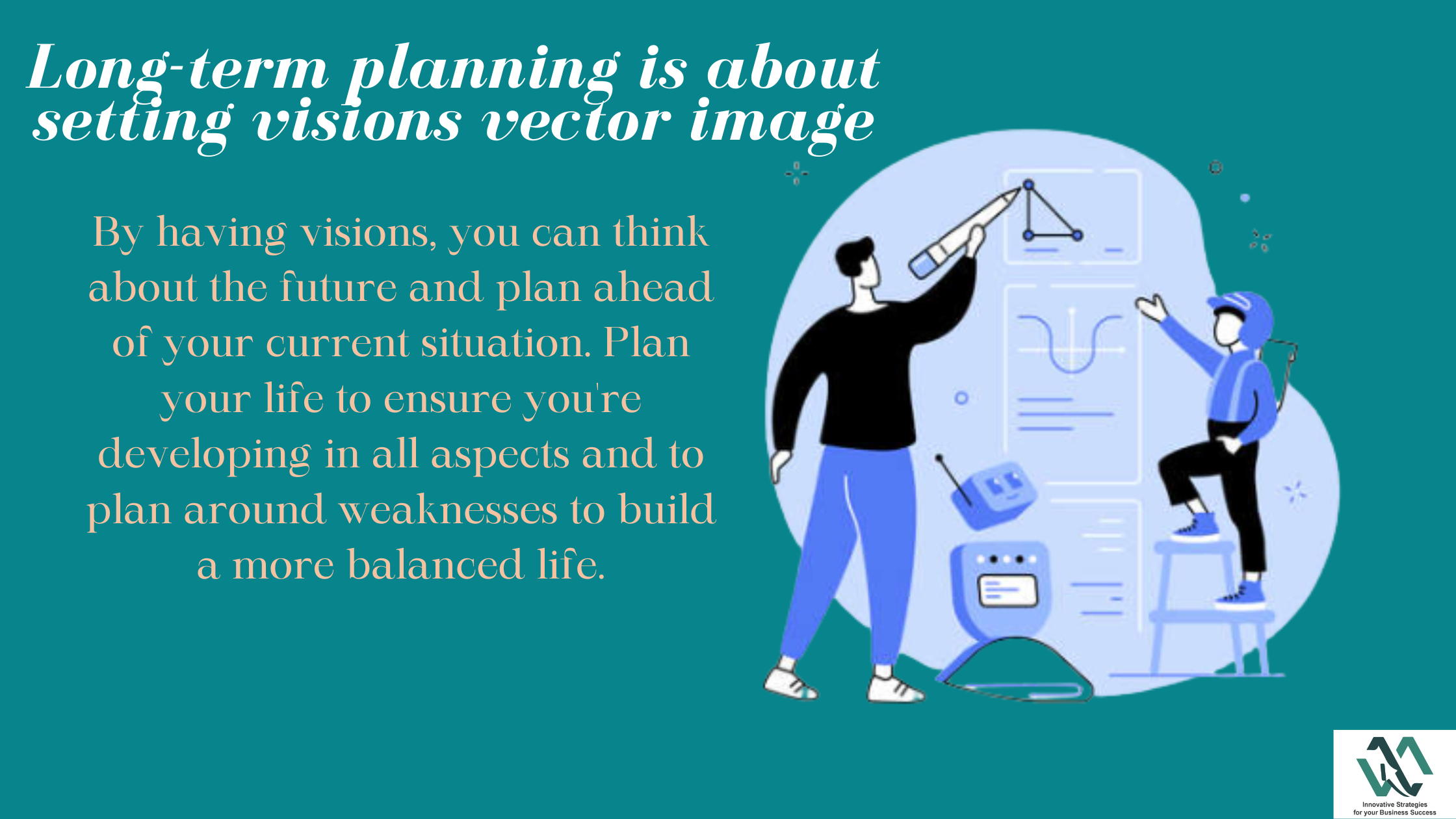How to Write a Five-Year Business Plan
Discover why the traditional five-year business plan can be a waste of time and how to set your long-term vision with a one-page plan instead.
In business, it’s hard to predict what’s going to happen next month, let alone three or five years from now. But that doesn’t mean you shouldn’t plan long-term. Your vision for the future is what gets you up in the morning and motivates your team. Your aspirations drive you to keep innovating and growing.
How do you make a long-term plan?
In a long-term or long-range business plan, you think about what the business might look like in five or ten years. Traditional 5-year business plans include financial projections, business strategies, and roadmaps.
However, for most businesses, long-range plans that stretch 5 or 10 years into the future are a waste of time. Anyone who asks for one seriously doesn’t know what they’re doing. I’m sorry if that offends some people. It’s true.
Long-term thinking still has value. You don’t need to create a long business plan with overly detailed metrics and milestones. We don’t know what the future holds, so anything you write down now might be outdated next year, next month, or even next week.
This is where long-term strategic planning comes in. The difference between a long-term business plan and a traditional business plan is that it’s less detailed and more focused on strategy. It’s more about the big picture than financial forecasting.
You can think of your long-term strategic plan as your aspirational vision. It defines your ideal direction, but it doesn’t affect your day-to-day or monthly decisions.
What’s the point of long-term business plans?
There’s no way to predict the future. We’re all just making our best guesses based on the information we have today. Sometimes trends in a market are pretty clear, so your guesses will be right. Sometimes you’re hoping that your intuition about what comes next is right when you’re looking around a corner.
I’m not saying thinking about the future is a waste of time. Entrepreneurs always think about the future. They have to have some faith in what customers want in the future. Entrepreneurs who are successful predict the future – they know what customers want and when they want it.
The world of entrepreneurship is unpredictable
Entrepreneurs are also often wrong. Just like us, they make mistakes. Entrepreneurs who succeed don’t let mistakes slow them down. They learn from their mistakes, adjust, and try again. Again. Again. You don’t have to be right all the time; you just have to keep trying until you get it right. James Dyson, the inventor of the iconic vacuum cleaner, tried 5,126 prototypes before he got it right.
Why are 5-year business plans a waste of time if thinking about the future isn’t? Because they usually follow the same format as a traditional business plan, where you project sales, expenses, and cash flow 5 and 10 years out.
Let’s be honest. For startups and new businesses, projections that far into the future are just wild guesses. You can’t use them for anything since they’re guaranteed to be wrong. These guesses can’t (and shouldn’t) influence your decisions. It’s just fantasy. Sales growth year-over-year is what you hope for, but there’s no guarantee. It’s not a good idea to make major spending decisions today based on the hope of massive sales in 10 years.
What’s the point of a long-term business plan?
What’s the point of outlining a long-term plan? Consider the future of your business without getting bogged down in the details here are a few reasons why.
1.Investors want to see your vision
First, and especially if you’re raising money, you need a vision. They’ll want to know where the business will be in five years, not just a year from now. Are you launching new products or services? Are you going international? Are you going to find new markets?
2.Plan your business’s future
Second, set goals for yourself and your team. What kind of high-level sales targets do you want to hit? How much overtime will your company get? As you get up and running, these goals can motivate your team and even help with hiring.
However, don’t spend too much time fleshing out all the details. You don’t need to figure out how your expansion will work five years from now or how much you’ll spend on office supplies. That’s just a waste of time.
Think big when it comes to long-range planning. Planning means revising and refining your business plan constantly. You’ll add details as you go, making a detailed plan for the next 6-12 months and a broader, vague plan for the long run.
3.There’s a long way to go
Companies with long research and development timelines make spending decisions now based on future results. These bets are made all the time in the pharmaceutical and medical device industries. It can take years for these industries to take an idea from idea to proven product with regulatory approval, so long-range planning is essential. There are a few other industries with similar development timelines, but they’re the exceptions, not the rule.
4.It’s a well-established, predictable business
Businesses with long histories of consistent sales and expenses with predictable growth might benefit from long-term, detailed planning. Even for those businesses, predictability doesn’t mean stability. You’re highly likely to be disrupted by a new company or changing customer needs and desires. Most likely, those long-range sales and profit predictions aren’t very useful.
Here’s what a 5-year plan should look like
Most 5-year business plans should be more like vision statements than traditional business plans, except for R&D-heavy businesses. Skip the detailed sales projections and expense budgets, but explain your vision for the future.
The vision for your business should explain what you hope to offer in the future, as well as who you hope to serve. If you’re successful, your plan should tell you who you’ll serve and how you’ll expand.
A future vision creates a strategic roadmap. Not a detailed plan with sales forecasts and expenses, but a way to get started and grow over time.
Here’s an example of what Nike’s long-term plan might have looked like if it had been written in the 1960s:
Nike will start by making high-end track shoes for elite athletes. As we build brand recognition among track and field athletes, we’ll expand nationally. Our shoes will be promoted by sponsored athletes.
We believe once we’re successful in the track & field segment, we’ll be able to expand beyond the US market and branch out into other sports, starting with basketball.
Having leadership and brand awareness in a sport like basketball will help us cross over into the consumer market. In addition to building a strong apparel brand, this will lead to significant growth in the consumer segment.
To my knowledge, Nike has never written a long-range business plan. Their plans evolved as they grew, like a proverbial plane.
If you have this kind of vision for your business, it’s helpful to articulate it. Your employees and investors will want to know what your vision is. Entrepreneurs want to know you’re thinking about the future months and years ahead.
What you need to know about writing a five-year business plan
It’s good to write down your long-term business vision. Your business can feel more stable and solidify key performance indicators.
Developing a long-range business plan is just an extension of your regular planning. It documents your target market, marketing strategy, and product or service offerings for the next one to three years.
Your five-year plan builds on your initial strategy and discusses what your business might do in the future. As I’ve mentioned before, a detailed five-year business plan is a waste of time.
Here’s a quick guide to writing a business plan that looks further into the future:
1.Write your one-pager
“Without a plan, even the most brilliant business can get lost. You need to have goals, create milestones and have a strategy in place to set yourself up for succes”
– Yogi Berra
You are less likely to forget your tasks if you write them down physically. Seeing that deadline, school assignment, or gym reminder in your own penmanship (that can’t be erased) might make you take notice! The same goes for your business plan. If you have content or ideas that will benefit you in the future, no matter how messy it looks, you have to write them down.
When you achieve something and check it off on paper, you’ll feel motivated.
Source: https://www.flickr.com/photos/wfryer/6727304737
Above is an example of how the person wrote his plan or development on paper and stuck it to the wall. He will mark his goals when he achieves something.
2.Decide if you need a traditional business plan
Many startup owners start their business plans with an executive summary. However, they should always start with the numbers. Any business plan needs forecasted financials. For example, if you show in the marketing strategy that you’ll hire a very expensive business development manager and the marketing budget is only $500 in the financial plan, then the investor is going to question the accuracy of the plan. It’s highly recommended to start the plan once the financials are ready. Presentation is important when the plan content is ready. Many business owners buy a business plan template for this reason. Now people make different business plans with new presentations. Business owners are adding video links to explain their strategy and answer investor questions. A business plan should be convincing. No recipe says the plan should be 10-20 pages. Investors will even read 50 pages if the wording or idea of the plan is interesting.
3.Set long-term goals and growth targets
According to an excellent business plan there is a 30% chance of growth if you have your milestones already decided or added to the plan.
Source: https://warrenaverett.com/insights/business-goals/
If you’re working on a business plan, think about where you want to be in 5+ years. Imagine what your business will look like. How many people will you have? What’s the number of locations you’ll serve? Are you going to introduce new stuff?
Once you’ve envisioned where you want your business to go, it’s time to document those goals in your business plan. Your business plan will be expanded to highlight where you want to go. Describe your initial target market in your target market section, for example. Next, you’ll describe the markets you hope to reach in three to five years.
To achieve your long-term goals, you’ll also need revenue targets that you think you’ll need to meet. When you’re growing your business, you should also consider the expenses you’ll incur.
For long-range planning, I recommend thinking about expenses in broad categories like “marketing” and “product development” without getting too buried in details. Decide what percentage of your sales you’ll spend on each. Marketing might be 20% of sales, for example.
4.Make a 3-5 year plan
You want to achieve your goals and growth targets. It’s “how” you’re going to do it.
Document your growth strategy in your business plan. You might be expanding your product line, or expanding your market. Think about how this will happen over the next 3-5 years.
Milestones are a good way to document your strategy. Those are interim goals you’ll set along the way to your bigger goal. Suppose you want to expand your business from a regional presence to a national one. It’s unlikely you’ll expand across the country at once. In most cases, you’ll expand into certain regions one at a time and eventually have a national presence. The strategy is figuring out what regions you’re going to expand into and why you’re picking them.
It’s also a good idea to have an “exit strategy” in your 3-5 year plan. When you’re raising money from investors, this part is usually required. They’ll want to know how they’ll get their money back. You can exit your business by selling it or going public. Typically, an exit strategy identifies potential buyers and shows you’ve thought about what your business might be worth.
5.Make your one-page plan work with your long-term plan
Your long-term business plan can help you grow your business. Your guide to where you want to go. Make small course corrections as you go to steer your business in the right direction.
Your one-page plan will reflect those small course corrections. It’s easier to update because it’s simple and looks at the short term. Once a month, set aside some time to review your plan. We’ll review your financial forecast, milestones, and overall strategy. You can adjust things if you need to. There’s no such thing as a perfect plan, so it’s okay to make changes.
As your business grows, you may also need to make corrections to your long-term plan. You may learn things about your market that change your assumptions and affect your long-range plan. It’s totally normal. Zoom out and review your long-range plan every quarter or so. Make corrections to your strategy and goals if you need to. Keep your plan alive so it gives you the guidance you need.
Long-term planning is about setting visions
Entrepreneurs are special because they have a vision. They have dreams about where their business will go. You should document your vision for the future and how your business will capitalize on it in a 5-year business plan.
If someone asks for your 5-year business plan. Don’t scramble to make a 5-year forecast and budget. You’ll be out of date tomorrow with your best guess. Communicate your vision instead.
How do you see your business 5 years from now and what do you think the market will look like? How are you going to be there to sell the solution to the problems that exist in 5 and 10 years based on what you think customers will want? Skip the fantasy budgets and forecasts.
Please download your brochure for your business plan below – Myinvestorchoice is ranked the number 1 Agency on Upwork for preparing business plans

 Our Samples
Our Samples  Support
Support 








Lula Hernandez
March 18, 2024I have been browsing online more than three hours nowadays, yet I never discovered any interesting article like yours. It’s beautiful worth sufficient for me. In my view, if all webmasters and bloggers made excellent content as you did, the internet will likely be a lot more helpful than ever before.